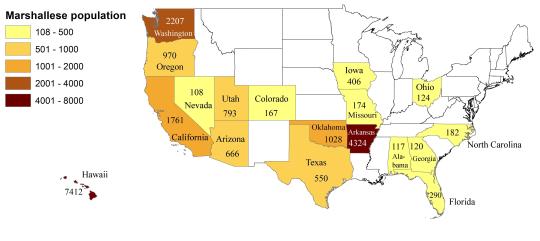#marshallese
Text

Marshallese woman, Marshall Islands, by Chewy Lin Photo & Film
#marshallese#marshall islands#oceania#micronesia#folk clothing#traditional clothing#traditional fashion#cultural clothing
213 notes
·
View notes
Text
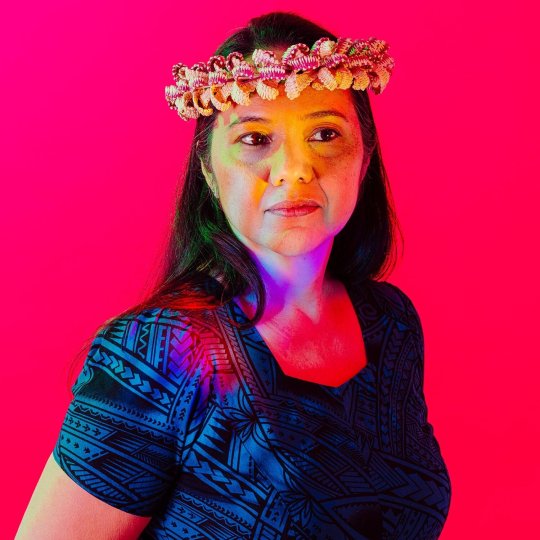
2 notes
·
View notes
Text
Footnote: This post originally appeared on Narratively and was published July 17, 2017. This article is republished here with permission.
1 note
·
View note
Text
Valleypoint Marshallese blends cultural heritage with a contemporary twist, crafting a welcoming space for youth and young adults to worship and explore their roots through a Southern Baptist lens.
“In very traditional Marshallese services, there are very few young adults or youth there. It’s mostly older Marshallese congregations. I wanted to make sure Valleypoint Marshallese was more modern and engaging for a younger audience,” Freddy Joklur Jr. said, the head pastor for the Marshallese sector of Valleypoint.
Read more about Valleypoint Marshallese.
Valleypoint Church
0 notes
Text
Sexy babe gets cumshot on her face swallowing all the jizz
Minha sogra bebada dormiu nua
Rachel James Has A Plan
Xxx boy to england gay Is it possible to be in enjoy with a family?
ballys casino las vegas restaurants
Luscious MILF Sydney Hail Straddles Hung Mailman
Gozando vestida de mujer bien caliente
Young gay hottie penetrates tight ass big dick style
young teens masturbating on snapchat
Nasty mmf threesome goes hardcore
#peperino#spinuli-#overmill#reballoted#tolbutamide#outdistances#relining#Marshallese#unequivalently#revivability#swift-footed#bromate#clews#chromomere#sigh#dissociative#prophyll#lcsymbol#pogonite#sneaked
0 notes
Text

Marshallese Baked Papaya with Coconut Cream (Vegan)
24 notes
·
View notes
Text
In this episode, Christina De La Rocha talks to Dr Hélène Jacot Des Combes, Disaster Risk Management and Climate Change Adaptation Advisor to the National Disaster Management Office of the Republic of the Marshall Islands. They discuss sea level rise, infrastructure that can adapt to climate change, and land reclamation and protection. Dr Des Combes speaks passionately about reparations (for decades of colonialism, the US’s testing of atomic weapons on the atolls of the Marshall Islands, forced relocation of the Marshallese people, climate injustice, and much more) and advocates for the Marshallese peoples’ right to their own lands.
You can read more about the Marshall Islands' unique position at the forefront of sea level rise at PacificaRisa.org. For further reading, check out the Republic of the Marshall Islands' Climate Change website here, you can read up on the Government of the Marshall Islands' Adaptation Communication (Dec 2020) here, and the World Bank's page on the Marshall Islands has some informative visuals.
Connect with Solarpunk Magazine at solarpunkmagazine.com and on Twitter @solarpunklitmag
Connect with Solarpunk Presents Podcast on Twitter @SolarpunkP, Mastodon @[email protected], or at our blog https://solarpunkpresents.com/
Connect with Ariel at her blog, on Twitter at @arielletje, and on Mastodon @[email protected]
Connect with Christina at her blog, on Twitter @xtinadlr, and on Mastodon @[email protected]
#Dr Hélène Jacot Des Combes#climate change adaptation#marshall islands#marshallese people#PacificaRisa.org#Solarpunk Presents#Solarpunk Futures#podcast#Christina#reparations#colonialism#atomic weapons testing#climate justice#climate injustice#land reclamation#sea level rise#season one episode 3
2 notes
·
View notes
Text
If we’re talking about nuclear justice, please don’t forget the Marshall Islands.
Many people have already pointed out how the Oppenheimer film glosses over the effects of nuclear testing on Indigenous communities in the United States, and it’s undeniable that more people need to know about this. More attention also needs to be paid to the Marshall Islands, where the legacy of US nuclear testing still affects the Marshallese people to this day. Most Americans don’t even know where the Marshall Islands is—let alone what the US government did there during the Cold War.
Between 1946 and 1958, the United States detonated 67 nuclear weapons on the Marshall Islands, which was then a US trust territory. The tests yielded the same level of radiation as 7,000 Hiroshima-sized atomic bombs, or 1.6 Hiroshima bombs every day for 12 years. The US government didn’t even evacuate some islanders from close proximity to the testing grounds. The fallout—which spread across the islands and beyond—caused deaths, miscarriages, stillbirths, radiation sickness, cancer, and many other health problems, with high cancer rates persisting to this day. Whole islands remain uninhabitable, and generations have been displaced.
It gets even worse. The US government knew that certain islands were too dangerous for human habitation and resettled the Marshallese there anyway; then US scientists studied the effects of radiation on them without their knowledge or consent in a secret program called Project 4.1. The US government secretly brought radioactive waste from Nevada and buried it in a concrete dome on Enewetak Atoll that is now vulnerable to erosion from the rising seas. And the US military also used the Marshall Islands for at least a dozen biological weapons tests. The US government did all of this to the Marshall Islands while it was a trust territory under US protection.
But in the decades since nuclear testing ended—even since the Marshall Islands’ independence in 1986—it has never received full compensation from the United States. Never.
There is a lot more that everyone should know about this history, and I recommend starting here to learn more:
625 notes
·
View notes
Text
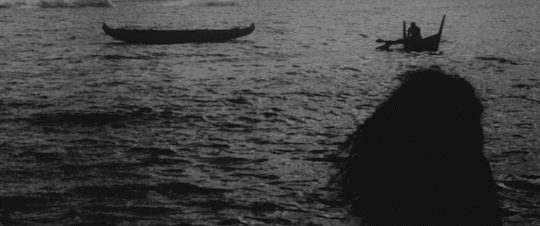
It's well-known among Godzilla fans that the 1954 Castle Bravo H-bomb test at Bikini Atoll, which irradiated the crew of the Lucky Dragon No. 5, was a major influence on the monster's original film. But that was just one of the 67 nuclear weapons the U.S. tested in the Marshall Islands from 1946 to 1958, blasts which still reverberate. The radiation they released has left Bikini Atoll uninhabitable to this day, and continues to affect residents' health.
Godzilla has visited the Marshall Islands before. Godzilla vs. King Ghidorah reveals that he lived on the fictitious Lagos Island as an ordinary dinosaur and stumbled into a World War II battlefield before an H-bomb test mutated him. (Well, he was mutated a different way after the Futurians altered the timeline, but let's not get into that.) The Monsterverse reimagines the Castle Bravo test as a covert attempt to kill him, as shown in Godzilla (2014), Godzilla: Awakening, and (soon) Monarch: Legacy of Monsters. The Marshallese themselves, however, are absent from King Ghidorah and appear only fleetingly in the Monsterverse tales.
What I'm getting at is that we're long overdue for a Godzilla story that centers the Marshall Islands, and ideally comes from the Marshall Islands. Japan and the U.S. have had him to themselves for too long; it's time Toho let the other country involved in his birth take a turn. The low-lying Marshall Islands face a very real "minus one" scenario as climate change causes the sea to rise—and potentially breach a massive concrete dome there that's full of American nuclear waste. Godzilla might be the perfect vessel to carry that story, and the U.S.'s nuclear legacy there, to a wider audience. After all, how many of us would know about the Lucky Dragon without him?
#godzilla#godzilla 2014#godzilla awakening#godzilla vs. king ghidorah#kaiju#marshall islands#bikini atoll
292 notes
·
View notes
Note
Thank you for letting me do this, really~~~
Like you mentioned in another post, this isn't specifically about oppenheimer or any narratives it portrays but the wider discussion that's been resurging around usamerican imperialism, nuclear weapons and the military/militarization in general. And this is so very long so I apologise.
The fact of the matter is, even after all the "lessons" learnt from bombing Hiroshima and Nagasaki, the us wanted to do further testing to see the full extent of the impact of nuclear weapons. These tests were carried out in the Marshall Islands in the Pacific, which was already heavily militarized by this point.
As usual when it comes to military interventions and imperialism by core nations, these tests were framed as a necessity "for the greater good", and to "end all wars", even framing its supposed necessity through religious narratives (which, well, christian missionary efforts).
There were 67 tests conducted from 1946 to 1958, and some of the weapons tested like the Bravo bomb dropped on March 1, 1954 over Bikini Atoll were many times more powerful than the ones used in WWII. As expected, these tests completely destroyed the Marshall Islands, from the ocean to the atmosphere to the land. So much radioactive fallout, so much devastation and literally uninhabitable to any living being.
I want to talk specifically about one of the most atrocious aspects of this whole ordeal which is that while the usamerican authorities evacuated the Marshallese people in Bikini and Enewetak during the 1948-52 testing period (operations sandstone, greenhouse and ivy) to nearby islands, they failed to do so for operation castle series begun in 1954. The relocated populations suffered as well, since there weren't enough resources on the islands they were resettled in to sustain this extra population, and of course, the nuclear fallout would affect them even though no weapons were directly tested in these islands.
The impact of the bravo bomb detonated over Bikini was mainly on the people from Rongerik, Rongelap and Ailinginae atolls, who were not evacuated until after the bomb was detonated at which point they were already exposed to high levels of radiation. In fact, the Rongelapese people were basically used as human test subjects as they were relocated back to Rongelap in 1957 where they remained until 1985 when they had to evacuate themselves.
The us actually declared Rongelap safe and that there were no long term effects from nuclear fallout in order to relocate them. Edward teller himself has gone on interviews to declare how little of an impact the bravo test has had on human lives. Iirc the documents regarding the tests were only declassified in the 70s, so Marshallese people were deliberately kept in the dark about the cause of the illnesses they were experiencing due to nuclear fallout. Here is Lijon Eknilang, a Rongelapese survivor talking about her experiences:
In June 1957, when we did return, we saw changes on our island. Some of our food crops, such as arrowroot, completely disappeared. Makmok, or tapioca plants, stopped bearing fruit. What we did eat gave us blisters on our lips and in our mouths and we suffered terrible stomach problems and nausea. Some of the fish we caught caused the same problems. These were things that had not happened before 1954. Our staple foods had never made us ill. We brought these problems to the attention of the doctors and officials who visited us. They said we were preparing the foods incorrectly, or that we had fish poisoning. We knew that was impossible because we had been preparing and surviving from these foods for centuries without suffering from the problems that appeared after 1954.
It has always been interesting to me that even the people who were not on Rongelap in 1954, but who went there with us in 1957, began to experience the same illnesses we did in later years. Foreign doctors and other officials called those people the “control group,” and we were told the sickness of that group proved our illnesses were common to all Marshallese. We did not believe that, and we learned only recently that the “control group” had come from areas that had also been contaminated by radioactivity from the weapons tests.
The usamerican authorities to this day do not acknowledge how serious and how much of an impact the nuclear weapons have left on the Marshall Islands and its people. There is no acknowledgement of the fact that people outside of the Enewetak, Utrik, Bikini and Rongelap atolls during testing were affected even when they show effects of radiation. There is no acknowledgement of just how much destruction they've brought upon these islands (also keeping in mind that animals were not evacuated). And of course, there is no acknowledgement of the fact that none of this was necessary in the first place (even if it can ever be called necessary). It was basically a large scale human experiment done for the sake of science and the "greater good", with little to no concern about the impact it would leave on the people of Oceania.
Oh, and there's also a huge crater left on Enewetak from the testing that's basically leaking nuclear waste into the soil, still contaminating the flora and fauna in area and beyond. There's so much spending by the us military in the Pacific region, especially now with the whole AUKUS agreement, but nothing has been done to properly contain this waste. Or actually address the violation of Marshallese people's human rights due to nuclear weapons testing. There has never really been any talks of reparations either, and whatever money and resources the us has spent has been woefully inadequate.
While the testing stopped decades ago, this is only a part of the ongoing militarization of Oceania by the US (and associated core and semi-periphery nations). Of course, this is all framed as selfless efforts by the us to prevent wars (which it always seems to be doing), for the greater good of humanity, to take us into further advancement and so on. Lastly, to mention a sliver of the role science has played in all of this: they were celebrating the discovery of new elements after the ivy mike detonation (1952), while people were suffering the impact of ongoing nuclear testing, and iirc, they were actually hoping to discover new elements from these nuclear reactions, so who's to say that these weapons were not made as a part of the race to discover elements, aka scientists' version of a dick measuring contest.
Sources and for more info for anyone interested:
Barbara Rose-Johnston. Nuclear Disaster: The Marshall Islands Experience and Lessons for a Post-Fukushima World [where I got the quote and most of the info from]
April L. Brown. No Promised Land: The Shared Legacy of the Castle Bravo Nuclear Test
Carl Zimmer. Nuclear Tests Marked Life in Earth with a Radioactive Spike [the sheer scope of the radioactive fallout from bravo]
Kit Chapman. Element Hunting in a Nuclear Storm
Edward Teller interview
.
243 notes
·
View notes
Text
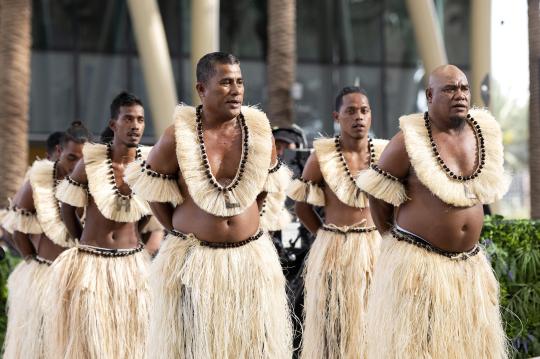
Marshallese dancers, from Marshall Islands, by virtualdubaiexpo
#marshallese#marshall islands#micronesia#oceania#traditional clothing#traditional fashion#folk clothing#cultural clothing
146 notes
·
View notes
Text
Please reblog for a bigger sample size!
If you have any fun fact about the Marshall Islands, please tell us and I'll reblog it!
Be respectful in your comments. You can criticize a government without offending its people.
22 notes
·
View notes
Text
[VOA is US State Media]
The Republic of the Marshall Islands and the U.S. signed agreements Monday evening that will give Washington a stronger presence in the Western Pacific and the right to deny China and other nations access to the islands’ territorial waters.
The agreements put in place Washington’s offer to provide $2.3 billion in economic assistance to the Marshall Islands over 20 years. In exchange, Washington will be able to deny access to the 2.1 million square kilometers surrounding the Marshall Islands.
When that is combined with the waters and airspace of the U.S. Pacific territories of Guam and the Northern Marianas, the U.S. military will gain control over a vast sector of the Western Pacific[...]
The Marshall Islands are the last of the three so-called Freely Associated States to reach final implementing agreements with Washington. The Republic of Palau and Federated States of Micronesia (FSM) signed their parallel agreements with Washington in May.
But the Marshall Islands wanted specific funds to address the environmental and health impacts of 67 U.S. atmospheric nuclear weapons tests between 1946 and 1958. Island residents face elevated cancer rates, among other health issues.
Environmental concerns include radioactive soil, dying coral reefs and a loss of biodiversity, according to a 2012 United Nations report.
The agreements signed Monday between the Marshall Islands and the United States do not contain any reference to additional funds to address the impacts of U.S. nuclear testing on the Marshallese people.
However, Ading said in his statement, that the Marshalls would “repurpose” $700 million under the agreement “to address the extraordinary needs of those who have suffered hardships and challenges from the nuclear testing program.”[...]
The House Natural Resources Committee has scheduled a subcommittee hearing on the agreements with the nations on Thursday to consider draft legislation. Ambassador Joseph Yun, U.S. special presidential envoy for compact negotiations, and Cantor are expected to testify.
Unlike the underlying agreements signed Monday, the draft legislation being considered by the committee includes compensation for nuclear testing for the Marshall Islands.
According to the documents, the draft limits compensation for American nuclear testing to “the people of” four of the 29 atolls within the Marshall Islands where a majority of the nuclear testing took place “and their descendants.”
17 Oct 23
17 notes
·
View notes
Photo
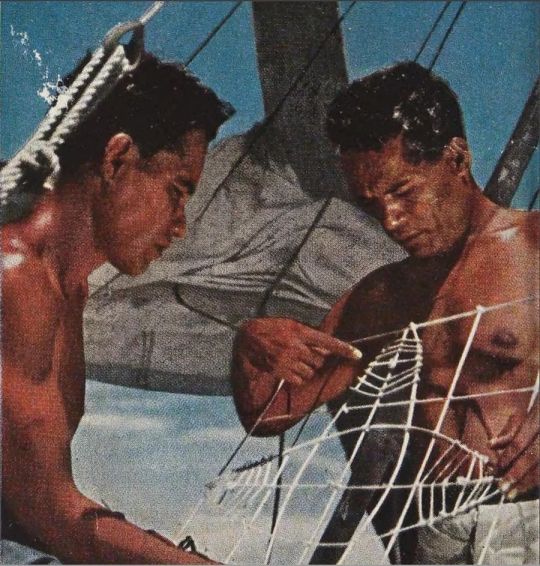
Marshall Islands. Photo by Robert Moore. "Islanders navigated by the stars, bird flights, and a stick chart like that studied by two Marshallese. Tiny shells represent islands, bent withes show direction of swells caused by prevailing winds. Waves, deflected by the islands, sometimes produce a confused sea, helping the primitive navigator sense his position." From "Men, ships, and the sea" by Alan Villiers, Alan, 1962. https://www.instagram.com/p/CnSUXxktZKm/?igshid=NGJjMDIxMWI=
74 notes
·
View notes
Note
Do you think it's a shame that Charles, being an experienced sea captain, had no tattoos?
I confess that when I saw "Do you think it's a shame that Charles...", I thought this was going to be about Charles Ryder. But no! Charles Boone! And firstly, Anon, let me say that from a purely lubricious (or, not to make assumptions, aesthetic) standpoint, I take your point. However.
Charles is not one of the working men before the mast; he is a whaling captain. Moreover, throughout the series, he is at some pains to disentangle himself from that as an exclusive identity. When addressed as Captain Boone, he gently corrects: "Mr." Also: at sea he gives orders, on land he gives choices (Anon, I whimpered.) And it is only his vampiric nemesis who refers to him insistently, mockingly, as "whaler." Is this because he knows Charles doesn't like it, or because his use of a harpoon has made him "Whaler" to the vampire community? Either way, I would argue that it's clearly hostile.
Furthermore, it matters that Charles is white. While a substantial minority of white sailors did get tattoos, the white protagonist of Melville's Typee (with which, I am convinced, this series is deliberately in dialogue) reacts to the prospect with alarmed distaste. But of course Charles is the widower of a Marshallese woman. So what I'm saying is that if Charles were to be tattooed, it would not be after the manner of sailors, but after the manner of his wife's people, a triangle on his chest representing the canoe that is body and home and the place where mythical families are formed. And when Tane follows his father to the sea, he definitely gets tattoos.
#...no i didn't expect to have this many thoughts and feelings about this show but here we are#chapelwaite#asks and answers#my insomniac chapelwaite diaries#now fully morphed into... whatever this is
10 notes
·
View notes
